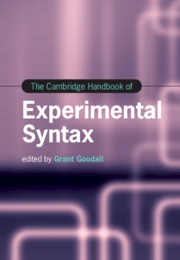Book contents
- The Cambridge Handbook of Experimental Syntax
- The Cambridge Handbook of Experimental Syntax
- Copyright page
- Contents
- Figures
- Tables
- Contributors
- Introduction
- Part I General Issues in Acceptability Experiments
- 1 Sentence Acceptability Experiments: What, How, and Why
- 2 Response Methods in Acceptability Experiments
- 3 Approaching Gradience in Acceptability with the Tools of Signal Detection Theory
- 4 Variation in Participants and Stimuli in Acceptability Experiments
- 5 Acceptability, Grammar, and Processing
- 6 Satiation
- 7 Acceptability (and Other) Experiments for Studying Comparative Syntax
- Part II Experimental Studies of Specific Phenomena
- Part III Experimental Studies of Specific Populations and Language Families
- Part IV Experimental Syntax beyond Acceptability
- Index
- References
3 - Approaching Gradience in Acceptability with the Tools of Signal Detection Theory
from Part I - General Issues in Acceptability Experiments
Published online by Cambridge University Press: 16 December 2021
- The Cambridge Handbook of Experimental Syntax
- The Cambridge Handbook of Experimental Syntax
- Copyright page
- Contents
- Figures
- Tables
- Contributors
- Introduction
- Part I General Issues in Acceptability Experiments
- 1 Sentence Acceptability Experiments: What, How, and Why
- 2 Response Methods in Acceptability Experiments
- 3 Approaching Gradience in Acceptability with the Tools of Signal Detection Theory
- 4 Variation in Participants and Stimuli in Acceptability Experiments
- 5 Acceptability, Grammar, and Processing
- 6 Satiation
- 7 Acceptability (and Other) Experiments for Studying Comparative Syntax
- Part II Experimental Studies of Specific Phenomena
- Part III Experimental Studies of Specific Populations and Language Families
- Part IV Experimental Syntax beyond Acceptability
- Index
- References
Summary
This chapter outlines a framework for using signal detection theory (SDT) to guide the design and analysis of acceptability judgment studies in experimental linguistics. It presents a worked example experiment on the syntactic phenomenon of D-linking (discourse linking) and wh-movement. It shows how to derive common SDT measures (like d_sub_a and s), how to do inferential statistics over those measures, and how to find additional theoretical and practical resources.
- Type
- Chapter
- Information
- The Cambridge Handbook of Experimental Syntax , pp. 62 - 96Publisher: Cambridge University PressPrint publication year: 2021
References
- 2
- Cited by



